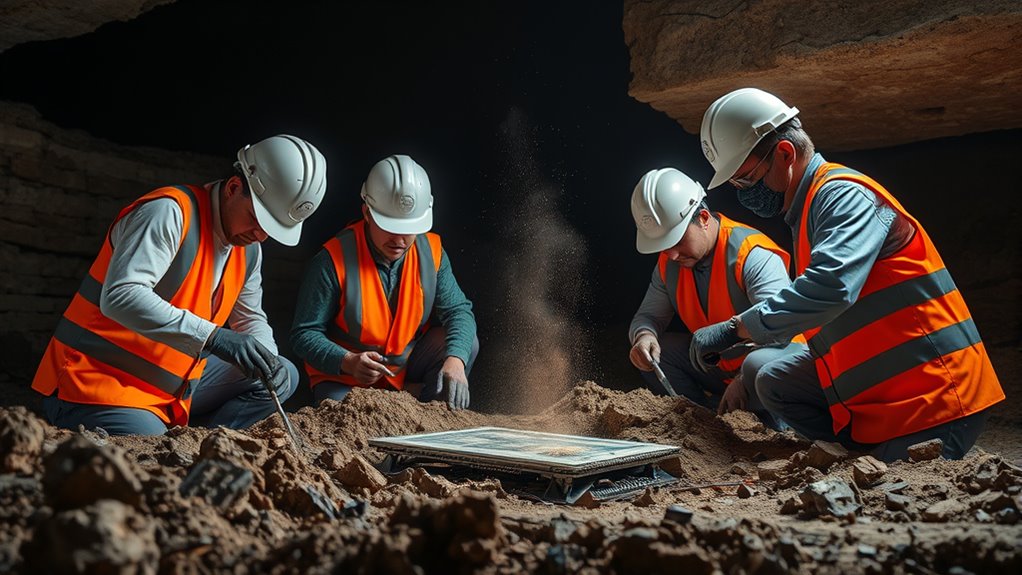Customer journey archaeology involves excavating your legacy systems to uncover hidden customer data, patterns, and insights. By evaluating your current infrastructure, you identify bottlenecks and outdated technology that hinder engagement. Developing a clear strategy helps prioritize data sources, modernize systems, and guarantee smooth migration. Using tools like visualization and analytics, you can interpret artifacts to improve customer experience. Keep exploring how these strategies can release valuable insights and boost future engagement success.
Key Takeaways
- Analyze legacy systems to identify data flows, dependencies, and bottlenecks affecting customer insights.
- Use metadata analysis and visualization tools to uncover hidden patterns in customer interactions.
- Map existing infrastructure to prioritize modernization and ensure seamless data migration.
- Focus on system decommissioning, cloud adoption, and security to enhance engagement capabilities.
- Transform raw data artifacts into actionable insights for improved customer journey strategies.
Uncovering the Hidden Layers of Customer Data

To truly understand your customers, you need to look beyond the surface and uncover the hidden layers of their data. Metadata analysis becomes your key tool, allowing you to interpret patterns and contextual clues that aren’t immediately visible. By examining user behavior across channels, you gain insights into their preferences, decision-making processes, and pain points. This deeper understanding helps you connect dots that raw data alone can’t reveal. Instead of relying solely on transactional information, focus on how users interact, what they seek, and how they navigate your systems. These subtle cues, when analyzed effectively, illuminate the customer journey in ways that guide smarter engagement strategies and foster stronger relationships. Incorporating mindfulness techniques into your data analysis process can enhance your awareness of subtle behavioral cues, leading to more accurate interpretations. Uncovering these layers transforms raw data into meaningful stories about your customers.
Assessing Your Legacy System Landscape

Understanding the hidden layers of customer data often reveals gaps or inconsistencies within your existing systems. To start examining your legacy system landscape, you need a clear inventory of all platforms, databases, and integrations in use. Identify which systems support critical customer interactions and note where data flows or bottlenecks occur. This step is essential for effective legacy modernization, as it highlights areas needing updates or consolidation. Pay attention to data consistency issues—discrepancies across systems can distort customer insights and hinder experience improvements. Mapping dependencies and overlaps helps you understand the complexity and risks involved. Incorporating mindfulness techniques during this evaluation process can help maintain focus and clarity amid complex system analysis. By thoroughly evaluating your current landscape, you lay a solid foundation for strategic modernization efforts, ensuring smoother transitions and more reliable customer data management down the line.
Developing a Strategy for System Excavation

You need to start by defining clear excavation objectives to guide your efforts effectively. Next, map out your existing system landscape to identify where valuable data resides. Finally, prioritize critical data sources to guarantee your efforts focus on the most impactful areas first. Incorporating knowledge of beginners guides can help ensure your approach is comprehensive and accessible to all stakeholders.
Define Excavation Objectives Clearly
Before diving into system excavation, it’s essential to clearly define your objectives. Knowing what you want to achieve helps you focus efforts on critical data and avoid unnecessary risks. Prioritize data preservation to guarantee valuable legacy information isn’t lost during the process. Clarifying your goals also helps anticipate excavation challenges, such as system complexity or outdated architectures. Establishing specific objectives guides your team in selecting appropriate tools and techniques, reducing scope creep and resource waste. Without clear aims, you risk missing key insights or damaging important systems. Take the time upfront to articulate your desired outcomes, whether it’s uncovering customer touchpoints or understanding legacy workflows. A well-defined strategy minimizes surprises, streamlines the excavation, and sets the foundation for successful discovery. Recognizing the importance of legacy systems in shaping cultural narratives can also inform your approach and priorities.
Map Existing System Landscape
Mapping the existing system landscape is a crucial step in developing an effective strategy for system excavation. You need to understand how different legacy systems connect and interact, which is where system mapping becomes essential. Use data visualization tools to create clear, visual representations of your current infrastructure. This approach helps you identify redundancies, dependencies, and potential bottlenecks. By visualizing data flows and system relationships, you gain an all-encompassing view of your technology environment. This clarity allows you to prioritize areas that require focused excavation efforts. Accurate system mapping ensures you’re not missing critical data sources and provides a solid foundation for planning your next steps. Ultimately, it enables you to approach legacy system dig-outs with confidence and precision. Recognizing system expiration and obsolescence early can help prevent unexpected failures during migration projects.
Prioritize Critical Data Sources
To develop an effective system excavation strategy, identifying and prioritizing essential data sources is important. Focus on sources that directly impact customer insights and operational decisions. Once identified, assess each source’s quality, guaranteeing data cleansing processes eliminate inaccuracies and duplicates. This step improves reliability and usability of the data. Stakeholder alignment is fundamental; engage teams early to understand their needs and confirm everyone agrees on which sources are most critical. Prioritizing crucial data sources enables you to allocate resources efficiently and avoid wasting time on less relevant information. By combining thorough data cleansing with stakeholder input, you streamline your excavation efforts and lay a solid foundation for uncovering meaningful customer journey insights. Incorporating data validation practices ensures that the information collected remains accurate and trustworthy throughout the process.
Tools and Techniques for Digging Deeper

Uncovering the true customer journey requires more than surface-level observations; it demands the right tools and techniques to dig deeper. Blockchain mapping can help you trace transaction histories and interactions across legacy systems, revealing hidden patterns and dependencies. Data visualization transforms complex data sets into clear, interactive visuals, making it easier to identify bottlenecks and opportunities. These tools enable you to connect fragmented data points, uncovering the underlying flow of customer interactions. By leveraging blockchain mapping, you gain a secure, transparent view of customer activities, while data visualization helps you interpret these insights quickly. Additionally, understanding Kia Tuning options and modifications can serve as an analogy for customizing and optimizing data analysis processes, allowing for tailored insights. Together, they provide a powerful approach to excavate deeper layers of the customer journey, turning raw data into actionable intelligence.
Interpreting the Artifacts: Gaining Customer Insights

Once you’ve gathered detailed customer interaction data through advanced tools like blockchain mapping and data visualization, the next step is to interpret these artifacts to gain meaningful insights. Focus on developing customer empathy by understanding their behaviors, pain points, and motivations revealed through these data points. Use data visualization to uncover patterns and trends that might be hidden in raw data, making complex information easier to grasp. This process helps you see the customer journey from their perspective, highlighting opportunities for improvement. By translating artifacts into actionable insights, you can better tailor your strategies to meet customer needs. Incorporating AI-driven analytics can further enhance your understanding by providing automated insights and real-time data analysis. Ultimately, interpreting these artifacts enhances your ability to create more personalized, empathetic experiences that foster loyalty and trust.
Integrating and Modernizing for Future Engagement

To prepare for future engagement, you need to assess your legacy systems and identify areas for improvement. Ensuring seamless data migration is essential to maintain continuity and open new opportunities. Building a future-proof infrastructure will support your growth and keep you ahead in an evolving landscape. Incorporating dynamic communication exercises for couples can enhance collaboration and adaptability within your teams.
Legacy System Assessment
Have you ever wondered how outdated systems can hinder your organization’s ability to engage customers effectively? A thorough legacy system assessment is essential for identifying outdated technology that impedes progress. During this process, you analyze current systems’ performance, dependencies, and risks, pinpointing areas ripe for legacy modernization. You’ll evaluate how legacy applications interact with customer journeys and where bottlenecks occur. This assessment also guides system decommissioning, helping you plan a smooth transition away from obsolete infrastructure. By understanding what’s outdated and what can be optimized, you set the stage for future engagement strategies. A comprehensive assessment ensures you prioritize modernization efforts efficiently, reduce technical debt, and improve customer experiences through targeted system upgrades. Recognizing narcissistic behaviors within your systems can help you identify manipulative dependencies that distort your organizational reality.
Seamless Data Migration
Building on your legacy system assessment, focusing on seamless data migration guarantees your organization can effectively integrate new technologies without disrupting customer engagement. To achieve this, prioritize data privacy throughout the process, safeguarding sensitive information and maintaining customer trust. Proper planning ensures data accuracy and integrity during transfer, reducing errors that could impact service. Staff training is essential; equip your team with the skills to manage new systems efficiently, minimizing downtime and resistance. Clear protocols for data handling and privacy compliance help avoid security breaches. A well-executed migration preserves customer history, preferences, and interactions, enabling personalized experiences post-migration. Ultimately, seamless data migration supports your modernization goals while maintaining the trust and engagement your customers expect.
Future-Proof Infrastructure
As technology rapidly advances, ensuring your infrastructure is future-proof becomes essential for sustained customer engagement. Embrace cloud adoption to increase flexibility and scalability, allowing your systems to adapt quickly to evolving needs. Modern infrastructure prioritizes cybersecurity measures, safeguarding customer data and maintaining trust amid growing digital threats. By integrating cloud solutions with robust security protocols, you create a resilient foundation that supports innovation and seamless service delivery. Moving away from legacy systems minimizes downtime and reduces maintenance costs, keeping your infrastructure agile. Staying proactive with cybersecurity and cloud strategies ensures you’re prepared for future demands, enabling you to enhance customer experiences continuously. Ultimately, future-proof infrastructure empowers you to evolve alongside customer expectations and technological advancements.
Frequently Asked Questions
How Can Legacy System Archaeology Improve Overall Customer Experience?
You can improve customer experience by using data mapping and user journey analysis to uncover hidden insights within your legacy systems. By identifying gaps and pain points, you tailor interactions and streamline processes. Digging through these systems reveals how customers truly engage, enabling you to personalize experiences, reduce friction, and foster loyalty. Ultimately, this archaeological approach transforms outdated data into strategic opportunities to enhance satisfaction and retention.
What Are Common Challenges Faced During Legacy System Excavation?
You face common challenges like data migration struggles, system obsolescence, and tight deadlines. Handling complex legacy architectures, you often encounter outdated technology, making integration difficult. Ensuring data accuracy while avoiding loss demands meticulous attention. You also battle with limited documentation and staff expertise, which can slow progress. Overcoming these hurdles requires patience, skill, and strategic planning to access valuable insights hidden within old systems.
How Do You Prioritize Which Systems to Analyze First?
When deciding which systems to analyze first, you should evaluate their vitality and user impact. Focus on systems that are crucial to daily operations or heavily used, as uncovering issues there yields the most benefit. Prioritize those with high user impact and potential risks, ensuring you address critical vulnerabilities early. This approach helps streamline your efforts and maximizes improvements where they matter most.
What Skills Are Essential for Effective System Excavation Teams?
You need a team with strong technical proficiency and an analytical mindset to effectively excavate legacy systems. These skills help you understand complex architectures, troubleshoot issues, and interpret data accurately. Your team should be comfortable with various tools and coding languages, enabling them to navigate and analyze historical systems efficiently. An analytical mindset guarantees you can identify critical insights and prioritize areas needing immediate attention, making your system excavation more targeted and successful.
How Can Insights From Legacy Systems Inform Future Digital Strategies?
You can use insights from legacy systems to shape future digital strategies by focusing on data mapping and system integration. By analyzing existing data flows, you identify gaps and opportunities for improvement. Understanding how legacy systems connect helps you design seamless integrations with new technologies, ensuring data consistency and efficiency. This approach allows you to make informed decisions that optimize customer experiences and drive innovation in your digital transformation efforts.
Conclusion
So, you’ve uncovered the ancient ruins of your legacy systems—congratulations! Now, don’t just leave those dusty artifacts untouched; modernize and connect the dots for a seamless customer journey. After all, who wants to be stuck in the stone age of data? Embrace the excavation, modern tools, and fresh insights. Your customers deserve a smooth ride, not an archaeological dig every time they interact. Time to dig up, clean up, and level up!









